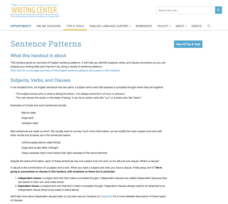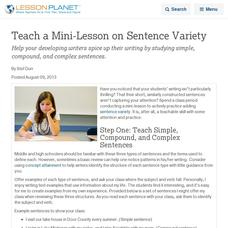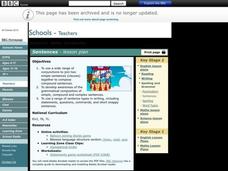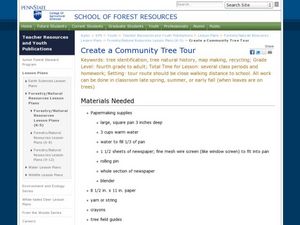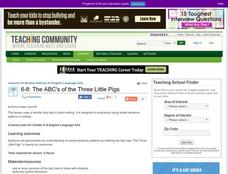Curated OER
Simple, Compound, Complex, and Compound-Complex Sentences in Your Writing
Encourage your young writers to make their writing more interesting by varying their sentence structures. Each color-coded slide offers definitions and models of sentence forms. The final slide in the presentation presents viewers with...
Curated OER
Review of Compound and Complex Sentences
An excellent language arts learning exercise. Learners read seven sentences and determine if each is simple, compound, or complex. In order to practice sentence combining, young writers join 10 sets of sentences to form compound...
Curated OER
Compound and Complex Sentences
Does your class need to work on compound and complex sentences? Consider this worksheet! This fine worksheet has learners use connecting words to join 8 sentences, so that simple sentences become compound and complex sentences. They also...
University of North Carolina
Sentence Patterns
In an ideal world, sentences in a college-level essay should feature a variety of sentence types. In reality, most papers stick to simple and compound sentences, two of the types a handout on sentence patterns discusses. Part of a larger...
Curated OER
Teach a Mini-Lesson Sentence Variety
Help your developing writers spice up their writing by studying simple, compound, and complex sentences.
Curated OER
Language with Linguistic Legos
Students visualize and manipulate sentences as building blocks, and, given a key, use Legos™ to demonstrate how to construct sentences of variety (simple, compound, complex, and compound-complex).
Curated OER
Sentences
Students create different types of sentences. In this sentence writing lesson, students use various types of sentences to make writing interesting. Students play online games and use the interactive whiteboard to practice.
Curated OER
Making compound sentences
In this combining sentences worksheet, students combine 2 sentences into 1 sentence. Students combine 12 sentences into 6 sentences.
Thoughtful Education Press
Compare and Contrast
Encourage readers to compare and contrast the information that they find in informational text with a variety of reading passages and worksheets. Learners read all about subjects in science, social studies, and literature...
Curated OER
Sentence Construction: What is a Sentence?
What must a sentence contain in order to be complete? What different types of sentences exist? Look at declarative, interrogative, and exclamatory sentences with this 17-slide presentation. Several example sentences are shown, and the...
Curated OER
Create a Community Tree Tour
Students study tree identification. In this tree identification activity, students design and assemble a tree tour booklet describing 5 trees found in their community. The booklet should feature common and Latin names of the species, a...
Houghton Mifflin Harcourt
Kinds of Sentences
Boost understanding of the four types of sentences with several exercises. To start off, read through the provided information about the types of sentences together. This will prepare your class to practice their new knowledge. Then,...
Curriculum Corner
“I Can” Common Core! 3rd Grade Language
Support third graders with developing their language skills using this Common Core checklist. With each standard written as an I can statement, children are given clear learning goals to work toward throughout the year.
Curated OER
The ABC's of the Three Little Pigs
Writers use varied sentence patterns. They listen to the story of Cinderella rewritten so that each sentence starts with the next letter of the alphabet. They create their own version of The Three Little Pigs using the same concept.
Shmoop
ELA.CCSS.ELA-Literacy.L.9-10.1
If you're completely lost on what grammar you should cover for Common Core skill L.9-10.1, look here! You will find some ideas and examples on what to include, making sure your learners can master the skill. The multiple choice quiz is...
Curated OER
Changing Verb Voice (Active/Passive) Practice
In this active voice and passive voice practice worksheet, students read an informative lesson. Students then respond to 5 questions that require them to identify the voice the sentences are written in and rewrite them in the opposite...



